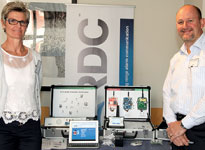
RDC has been designing and manufacturing alarm communications products since 1978. The company offers products that make use of VHF, GSM and even SMS for communicating alarm events reliably.
In today’s world of almost global cellular coverage, GPRS alarm communications offers a number of advantages to security companies. Communication is bi-directional and coverage is only restricted by the network provider’s footprint. This is ideal for companies requiring national or even international coverage and monitoring.

As an experienced operator in the cellular alarm communications market, RDC has announced the latest edition of its G-TX product line, offering the latest in GPRS communications. The new range offers the communications functionality one expects to find, but RDC’s sales director, Andrew Stead, says the company’s research and development team has added new features that separate G-TX from its local and international competitors.
Undoing the jammers
The first feature, which is extremely useful today given the increasing use of alarm jamming technology, is unique to RDC. This patent-pending technology is called Jam-Action. Stead explains that in traditional GPRS devices, once a signal is jammed, communication becomes impossible.
With the new G-TX incorporating Jam-Action, the system will detect when its communications are jammed. Then, when it is unable to communicate, the Jam-Action process triggers an internal relay and sends an output signal to another destination. This could be to a siren, a VHF transmitter, or any other output.
“This means that even if criminals do jam your GPRS signal, the system will automatically failover and send a trigger to another device, alerting the customer and/or security company of the problem in real time,” explains Stead. “Jam-Action is the first of its kind and offers a simple way to circumvent traditional jamming, whether the alarm system is installed in a house, factory or vehicle.”
Contact-ID dial tone
The second new feature in the G-TX series concerns the Contact-ID protocol, a common protocol used by alarm systems the world over to communicate with central stations. The process was designed for analogue phone lines in that the control panel waits for a dial tone before ‘calling home’. With ‘add on’ communication devices this can cause problems since there is no dial tone and leads to the system having to ‘blind dial’, creating unreliable and lengthy communications.
Stead says RDC overcomes this problem by now generating a dial tone as soon as the panel tries to connect. This speeds the communications process considerably by reducing the time it takes to raise an alarm. It can cut delays by between five and 45 seconds, saving valuable time in which intruders, for example, could have entered and disabled the alarm.
This will be a standard feature in all future RDC products to ensure that alarm events can be triggered immediately.
Talk to your alarm
The final feature in the G-TX range is the Internet-based communications platform RDC has designed. Since GPRS offers reliable bi-directional communications, the G-TX series can be programmed via the Internet by logging into the GTXConnect.co.za website. For those accessing the site from a mobile device, the mobile site will automatically be called up, allowing users to manage their alarm systems from their mobiles.
Users can therefore access their alarm systems at any time, from anywhere, depending on how they have set up their control panels. GTXConnect allows users to manage G-TX units remotely, change programming settings, view their unit’s status, control onboard relays, download signal logs, view SIM information, activate or deactivate alarms and even manage their accounts and users.
“All customers have to do is log into the GTXConnect portal from whatever connected device they have – a computer or a mobile device – and they have full control of their alarm system,” notes Stead.
He adds that the most important new feature of the new G-TX series is Jam-Action. “With so many people concerned about the possibility of their security systems being jammed and thus rendered useless, Jam-Action will ensure that users and security companies are immediately notified in the event of an attempted jamming.”
For more information contact RDC, +27 (0)11 452 1471, [email protected], www.radiodata.co.za
| Tel: | +27 11 452 1471/2 |
| Email: | [email protected] |
| www: | www.radiodata.co.za |
| Articles: | More information and articles about Radio Data Communications |
© Technews Publishing (Pty) Ltd. | All Rights Reserved.